New Forest Home Library Coming
Two proposals were unveiled at a public meeting of library board. Which one is better?
Two very different proposals for the redevelopment of the Forest Home Branch of the Milwaukee Public Library were considered at a public hearing before the library board Tuesday, December 2nd.
The meeting was held at the library, 1432 W. Forest Home Ave. The 1966 building is nearing the end of its functional life as a library, but the structure is in good shape, and could readily be converted to other uses, it appears.
The city asked developers to provide plans for a new building, which would include a residential component. This new template for library development ensures the buildings would generate tax revenue, which has not been the case with stand-alone facilities. Thus far, the Villard and East branch libraries have been recast in the new mold. The Forest Home and Mill Road branches are next on the list to be redeveloped.
Gorman Proposal
Gorman & Company, an Oregon, WI-based developer responded to the city’s Request for Proposal with plans to relocate the branch at the “Hills” building, 930 W. Mitchell St.
“The library would occupy the 15,000 square foot ground floor space with 20 ft. high ceilings. … Access to the library would be on Historic Mitchell St. … The ground floor is currently vacant and immediately available for a library.” The firm plans to provide 47 free parking spaces for library patrons (96 total). The current office floors above the four story building would be converted to approximately 33 apartments.
Gorman estimated the library component of the building would cost $4,400,000, financed by Historic Tax Credit Equity of $1,100,000 and construction financing of $3,300,000. The “White Box” buildout of the library would cost $1.5 million. The source of the library funding would include city funds, federal and state historic tax credit equity and possible New Market Tax Credits.
The upper floors would be a separate condominium unit, financed by conventional debt, WHEDA affordable housing tax credits and federal and state historic tax credits. The total project costs for both components is $10.4 million.
Gorman, which developed the Villard Branch library in 2011 at a total project development cost of $9.5 million, would partner with VJS Construction (the general contractor) and building owner Mitchell Investment Properties II. Herbert Hillman, a Mequon accountant, is listed as the agent for Mitchell Investment Properties.
Gorman Plans
Cardinal Capital / Journey House Proposal
The second option for development is from Cardinal Capital / Journey House, and calls for construction of a new building to replace the existing Dental Associates building on S. Cesar Chavez Dr. between W. Scott and W. Washington streets.
The $21 million project calls for a 16,500 square foot library, 51 units of affordable housing (including 24 for youth aging out of foster care), a coffee shop, and possibly office space for the Clarke Square Initiative. There would be 44 parking spaces for library patrons.
Journey House was founded in 1969 and is one of the principal social service agencies on the near South Side. It served for four years as the lead agency for the Zilber Neighborhood Initiative.
The Journey House proposal estimates the cost for the library at $7 million, including $1 million for the white box build out. The proposal also calls for 54,000 square feet of housing atop the library, and the construction of an additional 14,240 square feet of housing in the neighborhood at a cost of $14 million.
The project would require a basket of financing including New Markets Tax Credits, Low Income Housing Tax Credits, Federal Home Loan Bank AHP Funds, City of Milwaukee HOME funds, City of Milwaukee Housing Trust funds and “other fundraising sources.”
The project budget calls for a $4,500,000 City of Milwaukee loan, a $2,000,000 New Market Tax Credit Benefit Loan and $500,000 in “other fundraising” for the $7 million Library component.
The Journey House development partner is Cardinal Capital Management, Inc. It was founded in 2004, and its principals are Erich Schwenker and Daniel O’Connell. Drawings for the proposal were by Eppstein Uhen Architects.
Cardinal Capital / Journey House Plans
Comparing the Two Projects
Comparison of the two projects was complicated by the nature of the two competing proposals’ sources of funding.
Sam McGovern-Rowen, who spearheads library redevelopment for the city, had this analysis in response to a request from Urban Milwaukee:
“The total cost to the library is proposed to be the same for each at $4.5 Million. The difference is in how the dollars are allocated in the budgets, the timeline for the projects, and the structure of each deal.”
He adds that it’s not an apples to apples comparison because the Cardinal/Journey House project proposes to use library funding to leverage a New Markets Tax Credits transaction. For example, the total land cost for the Cardinal Capital/Journey House project is $2.33 Million. It is the main reason for the proposed New Markets Tax Credits transaction. The budget proposes to allocate $1.83 Million on the library side for land acquisition and demolition. The deal is structured in the proposal to leverage the library funding and cover the land value. It does not mean they are proposing we pay more than what we budgeted. It does mean a more complex transaction and possibly a longer timeline until we break ground.”
There is also the question of the two proposed locations for the new library, which are located about a mile apart.
The Library Today
Both the Forest Home (in 1966) and Mill Road (1970) branch libraries were designed by Burroughs & Van Lanen Architects, which became Architecture 360 in 1977. The Forest Home building has a steel frame construction, and the walls are nearly entirely glass. A 2000 computer room was installed inside the building, and was busy on a recent visit. The neighborhood has a large Latino contingent; many of the books are in Spanish or are bilingual. The library offers many courses in computers, reading, applying for health insurance and other issues of interest to the community. The Chilton’s auto repair catalogues get much use in this neighborhood where many people must rely on older vehicles, and on their own skills to keep the machines running.
A tremendous number of school children and their parents were in the building during the meeting of the library board. There is no doubt that a green card should not be a prerequisite for a library card.
There were perhaps four score of attendees for the hearing. Many apparently came from the neighborhood and appeared to support the local Journey House option. Among Journey House supporters was Ald. Jose Perez, who had submitted a letter in support of the proposal. Marsha Sehler was there in her role as an interested citizen.
The library also offers the assistance of volunteer tutors in a variety of subjects. Any lucky visitor needing math help on Tuesday would have been assisted by Mark Nicolini — the budget director of the City of Milwaukee, who one day will have to sort out the numbers for the construction of the new library.
Nicolini says he volunteers one night a week, partly just to get out of the house and to do some good. But he says sometimes his talent with numbers is not needed. “You should see some of the kids we get in here. I’m the one who needs the tutoring!”
Here is the library web page for the Forest Home Branch Library.
Here is the online community survey questionnaire for the Forest Home Branch Library.
The Mill Road Branch Library proposals will be reviewed at a public meeting Tuesday, December 9th at 5:30 p.m. at the library, 6431 N. 76th St.
Political Contributions Tracker
Displaying political contributions between people mentioned in this story. Learn more.
- November 30, -0001 - José G. Pérez received $250 from Erich Schwenker
Plenty of Horne
-
Milwaukee Modernism Gains National Awards
 Dec 15th, 2025 by Michael Horne
Dec 15th, 2025 by Michael Horne
-
New Rainbow Crosswalks Mark Milwaukee’s LGBTQ+ History
 Oct 8th, 2025 by Michael Horne
Oct 8th, 2025 by Michael Horne
-
Welcome Back, Tripoli Country Club!
 May 27th, 2025 by Michael Horne
May 27th, 2025 by Michael Horne


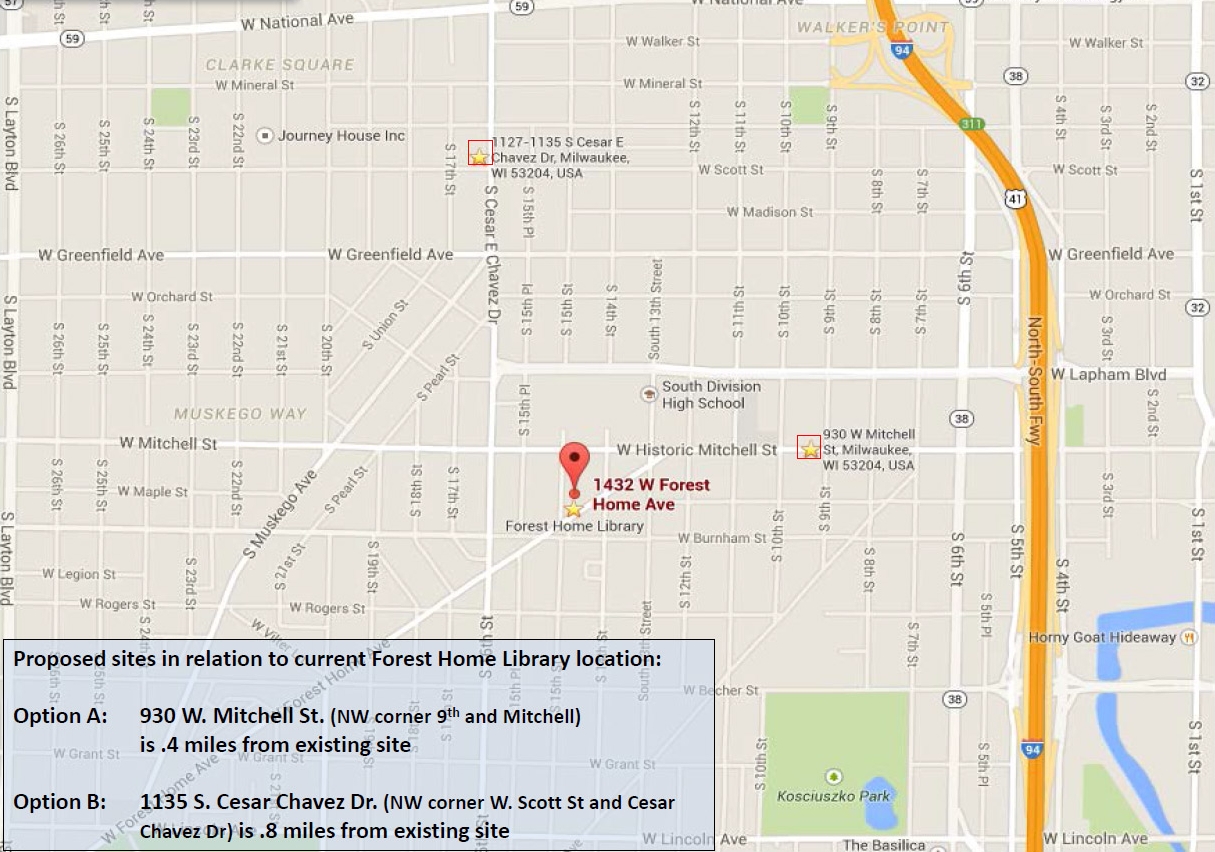
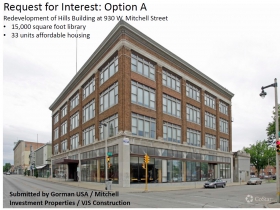
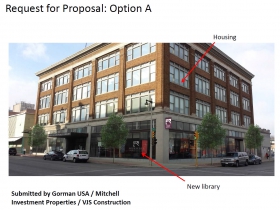
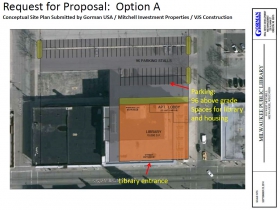
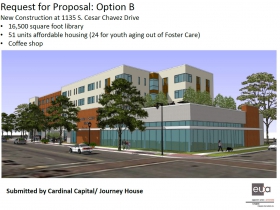
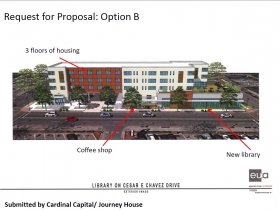
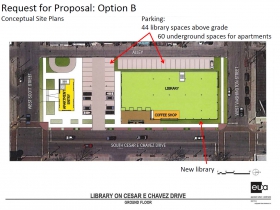




















Why not build them both? There’s “plenty of money”.
Yeah, that’s a good point. Money is merely numbers on a spreadsheet, really a construct of society that we agree to give it value, see the Rai stone of Yap. While the city cannot create money, the feds can.
Why aren’t we building up our civilian (more libraries) and economic infrastructure… as City Spec mentioned ‘ There’s “plenty of money” ‘
What is going to be done with the current Forest Home building? It’s an architecturally interesting building and it would be nice to see it reused even if the library is moved. Some day we’re going to wish we saved some of these mid-century buildings.
I’d love to see the Journey House version built. Selfishly it’s within walking distance of my house, but the extended use of the property sounds like a great plan.
Really hoping the city goes with Gorman’s proposal. Seems like a win-win: get a new library and restore/repurpose a large, underutilized historic building on a great stretch of Mitchell Street. Having a library on Mitchell would benefit the entire business district, which needs help. A library and the reopening of the Modjeska could take it to the next level and add a lot of momentum there.
@Sam I believe they will look for a new use for the building.
The old library is made from steel and glass and when energy consumption operational costs were compared, it used about 6 times the amount energy that a well designed building of today would use. I would not recommend it for any public and nonprofit use due to this ongoing operational cost.
All government buildings like this should be constructed or reconstructed to a high level of design and include solar panels.
I think more caution should be exercised when tackling projects like this, which is the great challenge of finding an architectural response to a program that raises the “contradiction” of wanting to make the building a library, but which nevertheless , intended disproportionately most of the area for residential use.
It is possible that due to this the volumetric outline of the proposed Cardinal Capital / Journey House, based on two distinct bodies in size and style which arrangement seeks to distinguish from one another due. Something that certainly is a valid approach as a design strategy.
However, the reality in this proposal is that the enormous proportions of the body that houses homes, coupled with the marked “residential character” expressed by the language adopted, gives the residential use excessive prominence regarding the Library (main object project), which merely relegated to a lower level in terms of their presence in the city.
In my opinion, in a situation like this, perhaps, a formal approach based on a more abstract and less figurative language, which minimizes the leading role of real estate development, could help the Library to assume its presence as an institution serving the community; which, from my point of view, this proposal looks completely reduced.